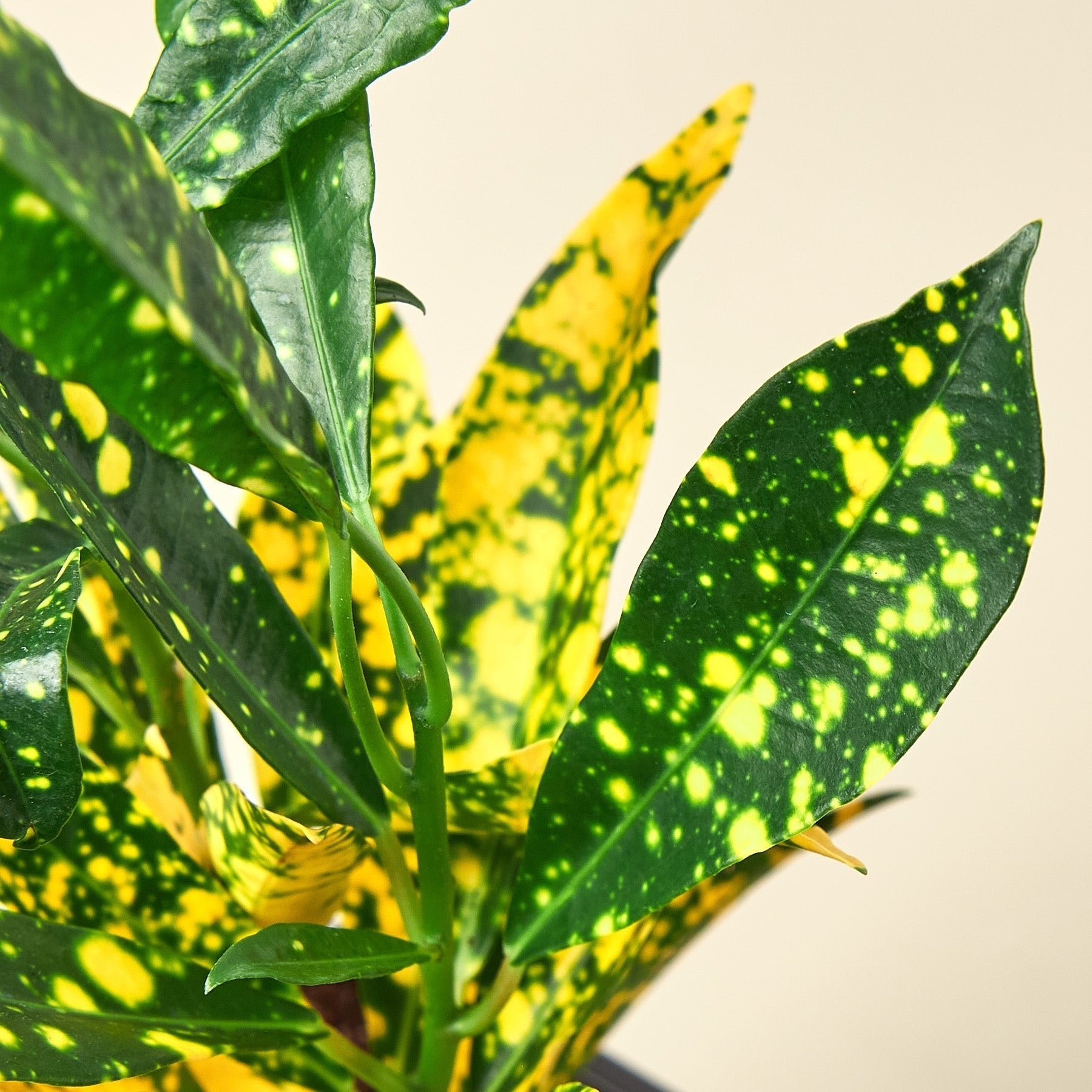Introduction
Welcome to the ultimate Croton Gold Dust plant care guide!
If you're a plant enthusiast or looking to add a touch of vibrant foliage to your indoor or outdoor space, the Croton Gold Dust (Codiaeum variegatum 'Gold Dust') is an excellent choice.
Known for its strikingly colorful leaves, this tropical plant can add a burst of sunshine to any setting.
In this detailed article, we'll delve into everything you need to know about caring for your Croton Gold Dust plant.
From lighting and watering requirements to propagation and common challenges, we've got you covered.
Let's dive in and nurture your Croton Gold Dust to flourish!

Croton Gold Dust Plant Overview
Before we dive into the care tips, let's get familiar with the Croton Gold Dust plant.
The Croton Gold Dust, a member of the Euphorbiaceae family, is native to Malaysia and the western Pacific islands. It is a popular ornamental plant known for its glossy, oval-shaped leaves with stunning golden-yellow speckles. The vibrant foliage features splashes of green, orange, and red, making it a striking addition to any room or garden.
This evergreen shrub typically grows up to 3-6 feet tall, with variegated leaves that can reach 2-4 inches in length. While it is primarily grown as an indoor plant in cooler climates, it can thrive outdoors in tropical and subtropical regions.
Now that we have a brief overview, let's explore the care requirements of the Croton Gold Dust plant.
Light Requirements
The first step to successful Croton Gold Dust plant care is providing it with the right amount of light. These plants thrive in bright, indirect light. Place your Croton near a window with filtered sunlight to maintain its vibrant leaf colors.
If the plant doesn't receive enough light, its leaves may lose their variegation and turn green. On the other hand, exposing the Croton Gold Dust to direct sunlight for extended periods can scorch its delicate foliage.
Watering
Proper watering is crucial for the health of your Croton Gold Dust. Like many tropical plants, it enjoys consistently moist soil but not waterlogged conditions. During the growing season (spring and summer), water your plant when the top inch of soil becomes dry to the touch.
In winter, reduce watering frequency, allowing the soil to dry out slightly between waterings. Always use room-temperature water to avoid shocking the plant's roots.
Humidity Requirements
Croton Gold Dust plants adore high humidity, mimicking their native tropical environment. To increase humidity levels, you can use a humidifier or place a tray filled with water and pebbles near the plant. Regular misting can also help maintain optimal humidity.
Temperature Tolerance
The Croton Gold Dust plant prefers warm temperatures between 60-85°F (15-29°C). It's essential to keep the plant away from cold drafts, as they can lead to leaf drop and other stress-related issues.
Fertilizing
To keep your Croton Gold Dust looking lush and vibrant, feed it regularly during the growing season. Choose a balanced liquid fertilizer and apply it every two to four weeks. Always dilute the fertilizer to half its strength to prevent burning the plant's roots.
Pruning and Shaping
Pruning your Croton Gold Dust is essential to maintain its shape and encourage bushier growth. Trim back leggy stems and spent flowers using sharp, clean shears. You can also pinch off new growth to encourage branching.
Repotting
As your Croton grows, it will eventually outgrow its current container. When you notice the roots circling the pot or protruding from the drainage holes, it's time to repot. Choose a slightly larger container with good drainage, and use a well-draining potting mix.
Propagating
Would you like to expand your Croton collection or share the beauty of this plant with friends and family? Propagating the Croton Gold Dust is a rewarding experience.
The easiest method is through stem cuttings. Select a healthy, non-flowering stem, and using sharp, sterilized shears, cut a section about 4-6 inches long. Remove the lower leaves and dip the cut end in rooting hormone before planting it in a pot with a well-draining mix. Keep the soil consistently moist until the cutting develops roots.
Common Challenges and How to Overcome Them
-
Yellowing Leaves: If your Croton Gold Dust's leaves turn yellow, it could be due to overwatering or underwatering. Adjust your watering routine accordingly and ensure proper drainage.
-
Leaf Drop: Sudden leaf drop may occur due to changes in environmental conditions or exposure to cold drafts. Find a more suitable location for your plant.
-
Pests: Croton Gold Dust plants can be susceptible to spider mites, mealybugs, and aphids. Regularly inspect the leaves and stems, and if pests are detected, use neem oil or insecticidal soap to treat the infestation.
-
Diseases: Overwatering and poor air circulation can lead to fungal issues like root rot and powdery mildew. Allow the soil to dry between waterings and ensure good airflow around the plant.
-
Faded Colors: Lack of sunlight can cause the vibrant colors of your Croton to fade. Move the plant to a brighter spot to restore its beauty.
-
Wilting: Wilting leaves may indicate underwatering or excessive heat. Check the soil moisture and adjust watering as needed.
FAQs
Q: How often should I water my Croton Gold Dust plant?
A: During the growing season, water your Croton when the top inch of soil becomes dry. In winter, reduce watering frequency.
Q: Can I place my Croton Gold Dust in direct sunlight?
A: While it enjoys bright light, avoid direct sunlight for prolonged periods, as it can damage the leaves.
Q: Can I grow my Croton Gold Dust outdoors?
A: Yes, in tropical and subtropical regions with warm temperatures, you can grow Croton Gold Dust outdoors.
Q: How do I increase humidity for my Croton Gold Dust plant?
A: Use a humidifier, place a tray with water and pebbles nearby, or mist the leaves regularly.
Q: Why are the leaves of my Croton Gold Dust turning green?
A: Insufficient light can cause the leaves to lose their variegation and turn green.
Q: Can I use tap water to water my Croton Gold Dust?
A: It's best to use room-temperature water, but avoid using water that contains high levels of fluoride or chlorine.
Conclusion
Congratulations! You are now equipped with the knowledge and expertise to care for your Croton Gold Dust plant like a pro. Remember to provide it with the right amount of light, water it correctly, and maintain the ideal humidity to ensure its vibrant foliage thrives. With a little love and attention, your Croton Gold Dust will reward you with a stunning display of colors, adding a touch of tropical paradise to your space.
Check out more Plant Care Tips


